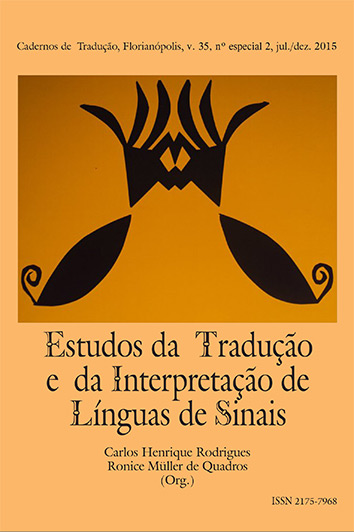Omissões na interpretação simultânea
DOI:
https://doi.org/10.5007/2175-7968.2015v35nesp2p269Abstract
Este artigo tem o objetivo de explorar pesquisas que tiveram como objeto de estudo as omissões na Interpretação Simultânea (IS), tanto nas Línguas Orais (LO) quanto nas Línguas Sinalizadas (LS), apresentando quais os conhecimentos existentes sobre este fenômeno que é intrínseco ao trabalho do intérprete profissional, contribuindo para as discussões sobre o assunto na área dos Estudos da Interpretação (EI) no Brasil e ainda oferecendo conhecimento para a formação destes profissionais.
Literaturhinweise
ALTMAN, H. J. Error Analysis in the Teaching of Simultaneous Interpretation: A Pilot Study. Fremdsprachen 33(3): p. 177-183, 1989.
BARBOSA, D. M. Omissões na Interpretação Simultânea de Conferência: Língua Portuguesa – Língua Brasileira de Sinais. 2014. 118 f. Dissertação (Mestrado) – Universidade Federal de Santa Catarina, Programa de Pós Graduação em Estudos da Tradução, Florianópolis, 2014.
BARIK, H. C. Simultaneous interpretation: Temporal and quantitative data. Language and speech, v. 16, p. 237, 1973.
______. Simultaneous interpretation: Qualitative and linguistic data. Language and speech, v. 18, n. 3, p. 272-297, 1975.
Brasel, B. B. (1976). The Effects of Fatigue on Competence of Interpreters for the Deaf, in Selected Readings in the Integration of Deaf Students at CSUN. (pp. 19-22, Rep.) (H. J. Murphy, Ed.).
COKELY, D. The effects of lag time on interpreter errors. Sign Language Studies, v. 53, n. 1, p. 341-375, 1986.
______. Interpretation: A Sociolinguistic Model. Burtonsville, Md.: Linstok. 1992.
DEAN, R. K.; POLLARD, R. Q. Application Demand-Control Theory to Sign Language Interpreting: Implications for Stress and Interpreter Training. University of Rochester School of Medicine. Journal of Deaf Studies and Deaf Education, 2001. Disponível em: <http://jdsde.oxfordjournals.org/content/6/1/1.full.pdf+html>. Acesso em: 16 nov. 2013.
GABRIAN, J.; WILLIAMS, G. The Effect of Interpreter Fatigue on Interpretation Quality, p. 1-35, 2009. Disponível em: http://www.gerardwilliams.net/index.php>. Acesso em: 22 jul. 2014.
GILE, D. Testing the Effort Model’s tightrope hypothesis in simultaneous interpreting – A contribution. HERMES. Journal of Linguistics, n. 23, p. 153-172, 1999. Disponível em: <http://download1.hermes.asb.dk/archive/FreeH/H23_09.pdf>. Acesso em: 15 nov. 2013.
KOPCZYNSKI, A. Conference interpreting: Some linguistic and communicative problems. Poznan: Adam Mickiewicz Press, 1980.
KORPAL, P. Omission in simultaneous interpreting as a deliberate act. Translation Research Projects 4, p. 103, 2012.
LUCIANO, A. H. T. A interpretação simultânea sob a ótica da linguística aplicada. 2005. 113 f. Dissertação (Mestrado) – Universidade Estadual de Campinas, Instituto de Estudos da Linguagem, Campinas, 2005.
MOSER-MERCER, B.; KUNZLI, A. and KORAC, M. Prolonged Turns in Interpreting: Effects on Quality. Physiological, and Psychological Stress. Pilot study. Interpreting 3 (I), p. 47-64, 1998.
NAPIER, J. Sign language interpreting Linguistic coping strategies. Coleford, UK: Douglas McLean. 2002.
______. Linguistic Coping Strategies of Sign Language Interpreters. Ph.D. diss., Macquarie University, 2001.
______. Interpreting omissions: A new perspective. Interpreting, v. 6, n. 2, p. 117-142, 2004.
NAPIER, J.; BARKER, R. Sign language interpreting: The relationship between metalinguistic awareness and the production of interpreting omissions. Sign Language Studies, v. 4, n. 4, p. 369-393, 2004.
PYM, A. On omission in simultaneous interpreting. Risk analysis of a hidden effort. Working version of a text published. In: HANSEN, G.; ANDREW, C.; HEIDRUN, G. (Eds.). Efforts and Models in Interpreting and Translation Research. Amsterdam/Philadelphia: John Benjamins. 2008. p. 83-105. Disponível em: <http://usuaris.tinet.cat/apym/on-line/translation/2008_omission.pdf>. Acesso em: 17 nov. 2013.
RUSSEL, D. Interpreting in Legal Contexts: Consecutive and Simultaneous Interpretation. Burtonsville, Md.: Sign Media. 2002.
Downloads
Veröffentlicht
Zitationsvorschlag
Ausgabe
Rubrik
Lizenz
Copyright (c) 2015 Cadernos de Tradução

Dieses Werk steht unter der Lizenz Creative Commons Namensnennung 4.0 International.
Autores têm autorização para assumir contratos adicionais separadamente, para distribuição não exclusiva da versão do trabalho publicada nesta revista (ex.: publicar em repositório institucional ou como capítulo de livro, com reconhecimento de autoria e publicação inicial nesta revista).





















































